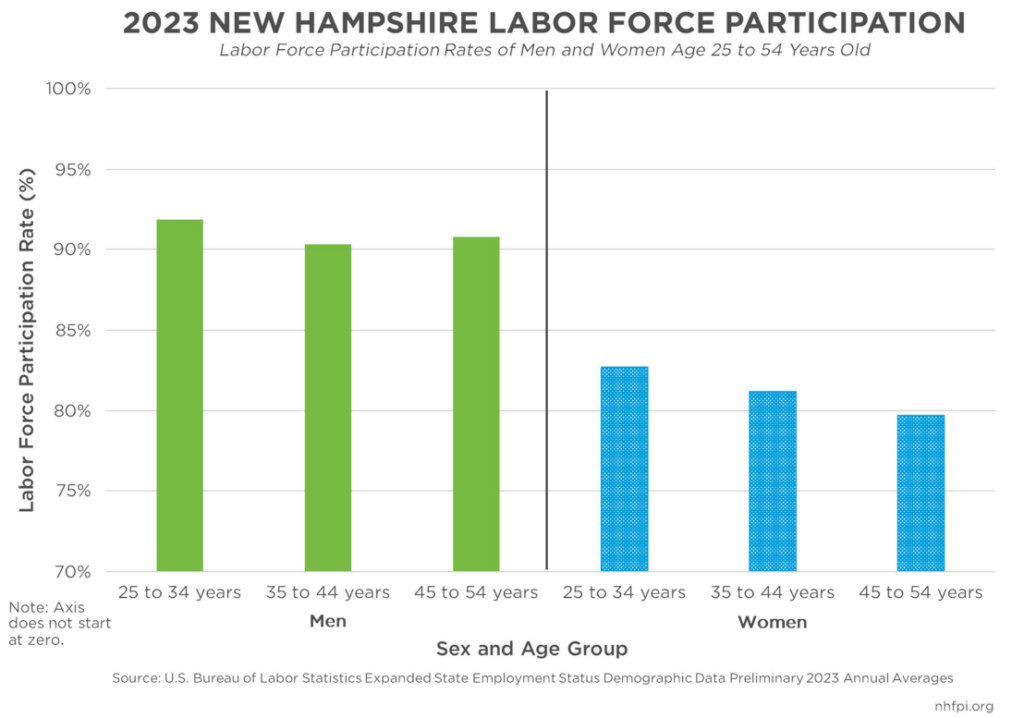First published in NH Bulletin, September 10, 2024
The size of New Hampshire’s labor force, which includes people who are working or actively looking for work, has not returned to the pre-pandemic levels of 2018 and 2019. Available data suggest barriers to both labor force participation and higher wage-earning opportunities for women, particularly women of color, are key constraints to both individual and overall economic prosperity.
Caregiving for children or older adults may be contributing factors to lower labor force participation rates in New Hampshire. Between July 2023 and July 2024, an average of approximately 5.8 percent of individuals not in the Granite State labor force reported they were caring for an older adult (about 4,500 people) or a child who was not in school or child care (about 16,700 people).
The national U.S. Centers for Disease Control and Prevention estimate that two of every three caregivers are women. If this proportion is applied to New Hampshire data, about 14,200 women may have been out of the labor force to provide unpaid caregiving to children or older adults, resulting in foregone wages. If each of the 14,200 women engaged in unpaid caregiving earned New Hampshire’s 2023 median full-time annual salary for all occupations of $49,980, the collective income gain would have been approximately $710 million.
These earnings could have provided financial support for women and their families, as well as served as economic stimulus for local and state economies. Importantly, this analysis may underestimate income loss because it does not account for individuals who are in the labor force but work reduced hours to provide care to one or more family members.
For women who can participate in the labor force, a higher proportion than men are more likely to be employed in caregiving professions. These jobs often come with lower pay and fewer benefits, particularly in early childhood education and older adult care.
According to the U.S. Census Bureau, in the first quarter of 2023, women constituted approximately 91 percent of New Hampshire’s child care workforce and nearly 88 percent of employees in the home health care services sector. During this period, Black or African American Granite Staters were overrepresented in the home health care services, representing 4.5 percent of employees in the sector compared to 2.1 percent of the overall New Hampshire population.
In 2023, earnings within these sectors were well below the Granite State’s median income for all occupations with child care workers earning a median salary of $32,490, and home health and personal care aides earning $34,420 in 2023. For context, the federal poverty guideline for a family of four in 2023 was $30,000.
Low pay and limited benefits may contribute to high turnover rates within these occupations, perpetuating workforce shortages. The New Hampshire Employment Security Office projects that annual turnover for child care workers will be 17 percent between the second quarter of 2023 to 2025 and approximately 15 percent for home health and personal care aides. While some policy initiatives have been implemented to address recruitment and retention efforts, including the $15 million state-funded Child Care Workforce Grants, it is too early to determine if the one-time funding was enough to address industry shortages.
Despite the low pay associated with some occupations in the care industries, services provided within these sectors are expensive and may be unaffordable to some families. The average price of child care for two children under 5 in New Hampshire was nearly $32,000 a year in 2023. The 2024 statewide annual private pay rate for nursing facilities, including atypical and specialized care, was approximately $141,700, according to state data.
For families with a worker earning at or below the annual salaries of employees in caregiving occupations, staying home to care for their own family members who might otherwise be in child care or nursing facilities may be more financially practical than engaging in paid employment. For employment-seeking individuals, pursuing a higher-paying occupation that is less physically, socially, and emotionally taxing could be appealing to some potential workers, further contributing to labor shortages in low-paying but high-stress occupations.
Additional policies that help ensure long-term investment in the child care and health care professions may encourage more workers, especially women, to remain in or pursue these important occupations. Addressing workforce shortages in these fields can help increase the quality of life for Granite Staters while also growing New Hampshire’s workforce, both of which are vital components for a vibrant economy and society.
To learn more, read the New Hampshire Fiscal Policy Institute’s August 2024 analysis Labor Force Participation and Caregiving Among Granite State Women.
Nicole Heller, Ph.D, is a senior policy analyst at the New Hampshire Fiscal Policy Institute, a nonprofit, independent policy research organization based in Concord and focused on the state budget, New Hampshire’s economy, and policies affecting Granite Staters, particularly those with low and moderate incomes. Learn more at nhfpi.org.

